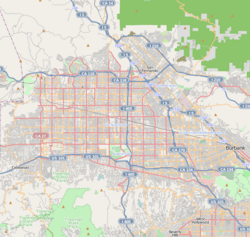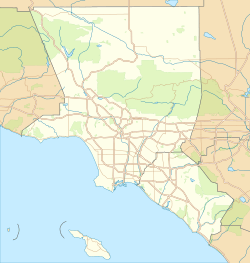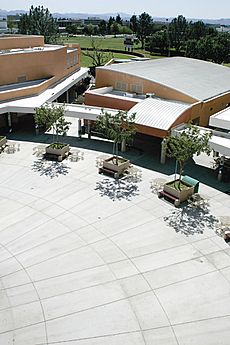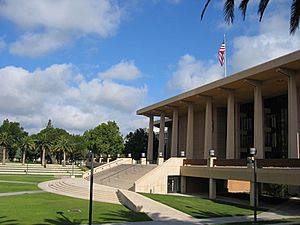Northridge, Los Angeles facts for kids
Quick facts for kids
Northridge
|
|
|---|---|
| Country | United States |
| State | California |
| County | Los Angeles |
| City | Los Angeles |
| Named for | Its location in the northern parts of Los Angeles |
| Population
(2008)
|
|
| • Total | 61,993 |
| ZIP codes |
91324–25; 91327–30
|
| Area code(s) | 818 and 747 |
Northridge is a neighborhood located in the San Fernando Valley part of Los Angeles, California. It's a busy community and home to California State University, Northridge, often called CSUN. You can also find the Northridge Fashion Center here, which is a popular shopping mall.
The area was first settled in 1908 and was called Zelzah. Later, in 1929, its name changed to North Los Angeles. But this caused confusion with other places like North Hollywood. So, in 1938, a local leader named Carl S. Dentzel suggested calling it Northridge Village. This name eventually became the shorter "Northridge" that we know today.
Northridge has a long history, dating back to the Tongva people. Later, Spanish explorers came to the area. The land was eventually sold by Mexican governor Pío Pico to Eulogio de Celis. His family then divided the land to sell it off in smaller pieces.
Contents
Northridge Population Facts
In 2000, about 57,561 people lived in Northridge. The neighborhood covers about 9.47 square miles. By 2008, the number of residents grew to 61,993. The average age of people living in Northridge in 2000 was 32. This was about the same as other neighborhoods in Los Angeles.
Northridge is known for having many different cultures. About 49.5% of residents were white, 26.1% were Latino, and 14.5% were Asian. Many people living in Northridge were born in other countries. The most common birthplaces were Mexico and the Philippines.
In 2008, the average household income was about $67,906 per year. This was considered high for Los Angeles. About 46.4% of homes were rented, while 53.6% were owned. The average household had 2.7 people living in it. In 2000, about 8.5% of the population were military veterans. This was a higher percentage compared to other parts of the city.
Where is Northridge?
Northridge is surrounded by several other neighborhoods. To the north, you'll find Porter Ranch and Granada Hills. On the east side is North Hills. To the southeast, it touches Van Nuys. South of Northridge are Lake Balboa and Reseda. Finally, to the west, it borders Winnetka and Chatsworth.
Northridge History Timeline
Early Inhabitants: The Tongva People
The Northridge area has been home to people for over 2,000 years. The first known inhabitants were the Tongva people. They had a village called Totonga in this area. The Tongva lived in round, dome-shaped houses. They spoke a language from the Uto-Aztecan family. Sadly, many of their ancient rock paintings were lost as Los Angeles grew.
Land Sales and Divisions
In the late 1840s, Mexican Governor Pio Pico sold a large piece of land to Eulogio de Celis. This was different from the usual way land was given out. By 1850, de Celis was a wealthy farmer in Los Angeles.
A few years later, de Celis's family divided the land. They sold the northern half, which was about 56,000 acres, to Senator George K. Porter and Senator Charles Maclay. Porter was interested in raising animals, while Maclay wanted to divide the land into smaller plots for new settlers. Francis Marion Wright, a young man from Iowa, worked for Senator Porter. He later helped develop the Hawk Ranch, which is now part of Northridge.
The Community of Zelzah
In 1908, the Southern Pacific Railroad built train tracks through the Hawk Ranch. Because of the railroad, the ranch was sold and divided into smaller properties. In 1910, the area was renamed Zelzah. This name comes from a biblical word for an oasis, referring to a water well nearby. The Zelzah Train Station was built where Parthenia Avenue and Reseda Boulevard meet today.
Also in 1910, a large balloon named America landed in Zelzah after a 31-mile trip. Soon after, a company began selling "Zelzah Acres" for $250 per acre. They advertised the land as having the "richest soil in California." They also highlighted how easy it was to get around thanks to the train station. The company noted that water was easy to find by digging wells. Water became even more important after the Los Angeles Aqueduct brought more water to the valley. The area grew so fast that new schools were needed. By 1912, Zelzah had its own post office.
The first church in Northridge, the Faith Bible Church, was built in 1917. By the 1920s, Zelzah became a center for shipping farm products. It remained a quiet, rural community for many years.
In 1929, residents voted to change the name to North Los Angeles. Reseda Boulevard, a main street, was paved in 1930. In 1938, the community's name changed again to Northridge Village. This was suggested by Carl Denzel, a local resident. Later, the name was shortened to just Northridge.
Growth After World War II
After World War II, Northridge grew very quickly. Farm lots were divided into neighborhoods with single-family homes. Many veterans and their families wanted to buy these homes. Businesses also started to open in the 1950s. San Fernando Valley State College opened in 1956, which is now CSUN. New industries moved into the area, leading to a building boom. The old train depot was taken down in 1961. Underpasses were built below the railway on Reseda Boulevard and Parthenia Street to make traffic flow better.
Northridge Education
In 2000, about 34% of Northridge residents aged 25 and older had a four-year college degree. This was an average number for the city but high for the county. The number of residents with a bachelor's degree or a master's degree was also high for the county.
Local Schools
In 1962, Nobel Junior High School in Northridge was the first school in Los Angeles to have air conditioning.
In the 1980s, there was a discussion about closing Prairie Street Elementary School. This school was on the California State University, Northridge campus and was used as a special "laboratory school" for the university. In 1984, the school board voted to close it. Some parents tried to get it reopened in 1985.
Here are some of the schools in Northridge:
Public Schools
- Andasol Avenue Elementary School
- Alfred Bernhard Nobel Middle School
- Topeka Drive Elementary School
- Balboa Gifted / High Ability Magnet Elementary School
- Northridge Academy High School
- Oliver Wendell Holmes Middle School
- Dearborn Street Elementary School
- Calahan Street Elementary School
- Napa Street Elementary School
- Northridge Middle School
- Parthenia Street Elementary School
- Granada Hills Charter TK-8
Private Schools
- Casa Montessori
- Our Lady of Lourdes
- Highland Hall Waldorf School (K-12)
- Art of Learning Academy
- St. Nicholas School (elementary)
- First Presbyterian Church of Granada Hill (elementary)
- Cornerstone Christian Academy
- East Valley Academy (K-12)
- Abraham Joshua Heschel Day School (Elementary and Middle)
Colleges and Universities
California State University, Northridge, or CSUN, is a big university here. It's part of the California State University system. Students can earn bachelor's and master's degrees in many subjects. CSUN is known for training many K-12 teachers. It also has strong programs in engineering, business, and film.
CSUN started in 1956 as the San Fernando Valley Campus of Los Angeles State College. It became San Fernando Valley State College a few years later. In the early 1970s, it was renamed California State University, Northridge. By 2016, almost 40,000 students were attending CSUN.
A study in 2004 showed that CSUN helps the local economy a lot. It brings in between $663 million and $686 million each year. CSUN also provides jobs for many people, both directly at the university and in other local businesses.
Northridge Entertainment and Culture
Movies and TV Connections
Many famous people have lived in Northridge. Silent movie star Janet Gaynor and her husband owned a large estate here. Later, actors Barbara Stanwyck and Robert Taylor bought it. Actor Jack Oakie also lived on the property. The Oakie house was almost torn down, but in 2010, the city decided to buy it and its 10-acre ranch. It's now called Oakridge Estate Park.
Northridge was once known as the "Horse Capital of the West." There were regular horse shows, rodeos, and country fairs. Marion Marx, who was married to Zeppo Marx, and Barbara Stanwyck started a horse breeding farm called Marwyck Ranch.
Devonshire Downs Music Festivals
In the late 1960s, Devonshire Downs hosted two big rock music festivals. The 1967 Fantasy Faire and Magic Music Festival featured bands like The Doors and Jefferson Airplane.
The more famous Newport Pop Festival happened in 1969. It was a huge three-day event with Jimi Hendrix and many other top artists. For a short time, it was the biggest music festival ever, until Woodstock happened later that summer. Like Woodstock, it had problems with many people trying to get in without tickets. Some young attendees camped out nearby. Local residents in Northridge were surprised to see so many "hippies" in their neighborhoods. After these festivals, rock music festivals were soon banned in the area.
Earthquakes in Northridge
The 1994 Northridge earthquake was named after Northridge. Early reports thought the earthquake started right under Northridge. However, later studies showed it actually started in nearby Reseda. This earthquake was very powerful. Freeways collapsed, and many buildings were badly damaged. The ground shook so hard that structures were lifted off their foundations. Even with the damage, the Northridge Hospital Medical Center stayed open. It treated over 1,000 patients in the first few days after the 6.7 magnitude quake.
This was not the first strong earthquake to affect the area. On February 9, 1971, the San Fernando earthquake (also called the Sylmar earthquake) struck. It had a magnitude of 6.5.
Places to Visit in Northridge
- Brent's Deli: A famous deli.
- CSUN Botanic Garden: A beautiful garden on the university campus.
- California State University, Northridge (CSUN): The large university.
- Donald E. Bianchi Planetarium at CSUN: A place to learn about stars and planets.
- Northridge Fashion Center: A large shopping mall.
- Northridge Hospital Medical Center: A major hospital.
- Studio 606 West: The recording studio for the rock band Foo Fighters.
- The US Metric Association: An organization that promotes the metric system.
Northridge Hospital Medical Center
The Northridge Hospital Medical Center is a large hospital with 411 beds. It serves about 2 million people in the San Fernando Valley. It is one of only two hospitals in the Valley that can treat very serious, life-threatening injuries.
Parks and Recreation
Northridge has several parks where you can play and relax.
The Northridge Recreation Center is located at 18300 Lemarsh St. It has an indoor gym that can also be used as an auditorium. The park also offers barbecue pits, a lighted baseball field, lighted indoor and outdoor basketball courts, and a children's play area. You can also find picnic tables, a lighted soccer field, and lighted tennis courts. There's also an outdoor heated swimming pool that's open during certain seasons.
Dearborn Park, at 17141 Nordhoff Street, has lighted outdoor basketball courts, a children's play area, picnic tables, and lighted tennis courts.
Vanalden Park, at 8956 Vanalden Ave., is a smaller park. It has a horseshoe pit, a jogging path, and picnic tables.
Famous People from Northridge
Many notable people have connections to Northridge, including:
- Brooke Abel, an Olympic synchronized swimmer
- Ariane Andrew, a professional wrestler
- Matt Cassel, a professional football player
- Jarron Collins, a professional basketball player
- Jason Collins, a professional basketball player
- Linda Fratianne, a figure skater
- Brian Grazer, a film and television producer
- Cole Guttman, an ice hockey player
- Jackie Earle Haley, an actor
- Travis Kalanick, co-founder of Uber
- Ryan Kalish, a professional baseball player
- Antonia Lofaso, a celebrity chef
- Casey Matthews, a professional football player
- Kyle, an entertainer
- Clay Matthews, a professional football player
- Niecy Nash, an actress and comedian
- Malcolm Smith, a professional football player
- Duffy Waldorf, a professional golfer
- Jeff Weaver, a Major League Baseball player
- Jered Weaver, a Major League Baseball player
See also
 In Spanish: Northridge (Los Ángeles) para niños
In Spanish: Northridge (Los Ángeles) para niños






